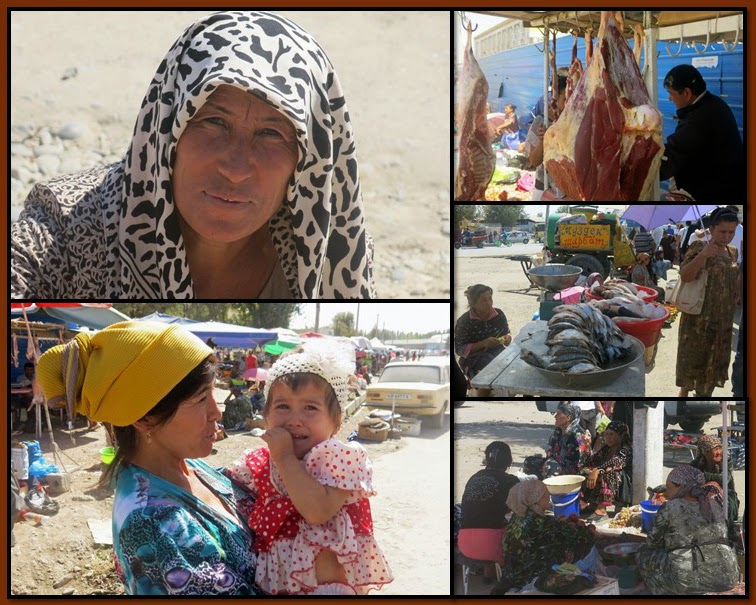Before really starting this post, please find the above photo (which you can also find in a collage below), which participates in a photo contest. It represents a woman on the local food market at Shahrisabz. You can actually vote for it, by going here. (http://www.voyageursdumonde.fr/voyage-sur-mesure/grand-prix-photo/portraits-de-voyages/shahrisabz)
After a few
days in the charming and beautiful city of Bukhara (see preceding post), time
for a new bus ride in the direction of Shahrisabz via Karchi, along roads of
different qualities alongside a rather arid country, with some views of old
settlements, some gas industry complexes, the 16th century strategic
(toll) bridge over the river Kashkadarya, different mosques and madrasas.
Shahrisabz
is one of the oldest cities in Central Asia. Alexander the Great spent quite
some time here with his wife Roxanna, regional native, around 328-327 BC. The
city was conquered by Arabs in 710…
…but, especially, it was around 1350 the birthplace of the Turko-Mongol ruler Timur
(Tamerlane), today some kind of national hero in Uzbekistan. He was (and is)
probably less appreciated in some neighbour countries, having conquered and
sacked cities like Baghdad, Delhi, Damascus… , having destructed the Christian
Church in much of Asia. He managed to unify large parts of the Muslim world –
he referred to himself as the “Sword of Islam”… It is estimated that his
campaigns meant the death of some 17 million people, equal to 5% of those days’
world population. Timur is however clearly considered as a military genius and
tactician and also as a great patron of art and architecture.
Here we can see a contemporary portrait of him
and an illustration of the empire he controlled at his death in 1405, including
most of today’s ‘stan-countries, Iran, large parts of Iraq and Syria.
In Shahrisabz
one can visit the rests of the Aq-Saray Palace, which Timur ordered in 1380.
Only traces of its 65 m ((215 ft) gate-towers remain. Timur has his statue. Important
works are ongoing to embellish it environment.
Close to
the nearby Dar ut Tilovat and Dorus-Saodat mosques and mausoleums you can find what was
intended to be the tomb of Timur. There is some kind of a bunker with an underground
chamber, discovered in 1943. Timur was however never buried here, but in
Samarkand (more about it in a later post).
Again, a
visit to the local nearby market.
From
Shahrisabz to Samarkand, the road crosses some mountains (see also top picture)
and buses are not allowed. The streets go from wide to narrow and jumpy,
sometimes with a cow passing…
Cows,
horses, donkeys... walk along without any protecting fences and are nice to
look at.




























11 comments:
Thank you for the photos and especially the map. I've also voted. I hope I did it right as it was in french!
Bonjour cher Peter,
Comme j'avais manqué l'épisode numéro 2 je viens de passer un long moment en ta compagnie.
Tes photos sont exceptionnelles et captivantes.
J'ai bien évidemment voté pour ce très joli portrait de femme.
L'architecture et les décorations sont magnifiques. Un plaisir des yeux à chaque instant !
Je prends beaucoup de plaisir à me promener avec toi.
Gros bisous ❀ ☼ ❀
Ah ah tu te lances dans les concours, bravo!
J'aime beaucoup ces photos de groupes: hommes d'un cote, femmes de l'autre :-)
Je me demandais justement a quoi ressemblaient les etals de marche.
Quel reportage!
Bon sang, ça me rappelle toujours quelque chose.
C'est normal docteur?
Quel beau reportage !
C'est super sympa de nous faire voyager sans bouger de chez nous.
Très beau portrait pour lequel je viens de voter.
Elle est toujours aussi marrante, Dédé.
Le voyage en voiture était juste mythique, on a failli écraser 158908908 vaches et se prendre une autre voiture dans la tronche.
Dédé: Sans exagération ! :-)
Love your photos!
All my life I wanted to have eyes the color of those onion roofs...
I voted already. Hope you win....
Thank you, Peter.
Maria
La dame (c'est une dame ?) dont tu as fait le portrait a vraiment le type caucasien, comme Lawrence d'Arabie alias Peter O'Toole, ne trouves tu pas ?
La lumière sur tes précédents messages est particulièrement belle et met bien en valeur l'architecture
Pas de grillage anti-bétail, c'est kif kif dans les Pyrénées mais aussi cela arrive en Normandie. Heureusement que ce n'étais pas toi qui étais au volant...
Les déplacements en voiture dans les contrées éloignées sont souvent assez aventureux. On en rit...après. Quant à ton portrait, je remarque surtout l'élégant foulard qui couvre sa tête.
What an adventure you are having!
Post a Comment